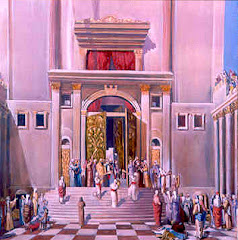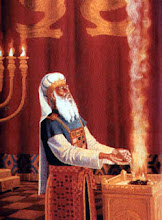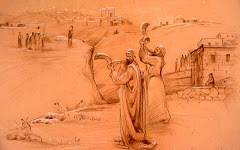
The Beit Hamikdash was the sacred abode of Hashem. What a providential aura prevailed among the people of Israel and the Creator of the Universe! What a beauty and holiness in this splendid mansion speaks! Indeed, during the days when the Beit Hamikdash was around there was no one around the world as extraordinary as this building, built with large, heavy stones, arranged so exceptional. Some were covered with a blue-green marble, similar to sea waves, thereby transmitting observador.All of the gates of the Beit Hamikdash were made of pure gold, like most of the utensils used in the Temple. There were thousands of flowers and candelabras decorated with gold buttons, and when lit, the Beit Hamikdash was immersed in a sea of light.
The Temple was divided into two main parts: the hall of the Temple-and heijal Temple. In the hall were prepared three of the most important tools of the Temple. In the southern sector was placed the golden menora, composed of seven arms in the northern sector was located lejem hapanim the table (table with the offering of bread), and in the middle of the hall, stood the altar of gold, used for incense. At the end of the hall was another room, the Kodesh Hakodashim, the site of the utmost sanctity of the Temple. Two curtains adorned with gold thread and covered their separate entry hall. But no one running these curtains and entered the Kodesh Hakodashim except the high priest once a year: on Yom Kippur.
What was in the Kodesh Hakodashim? In this sacred place was the ark that kept them in the Ten Commandments. The ark had a gold coverage, and it had two cherubim of gold. The cherubim spread their wings on one another to symbolize the love of Hashem by Israel. The Second Temple no longer had the ark, and in its place was the "cornerstone" hashtia-even so-called because from it was created the world. Desde the hall of the temple, a dozen steps leading into the courtyard of the priests/ Kohanim. It was a large courtyard where the altar was of copper, also called the outer altar. On this altar was offered the great majority of the sacrifices of Beit Hamikdash. Another important tool of the Temple was in the courtyard of the priests. It was the sink-copper-bright Kior in which the priests washed their hands and feet before providing its service in the Temple.
Near the Courtyard of the priests was the courtyard of the Israelites. This immense courtyard was concentrated all. People of Israel that pilgrimage to Jerusalem and went to the temple to pray and offer sacrifices. And although this was a very large mass of humanity, reaching thousands of people, however in the Courtyard used to happen a miracle: "The town was crowded but to kneel comfortably." At the corner of the courtyard of the Israelites there was a room of great significance called Lishkat Hagazit. He met the Sanhedrin to try monetary cases and cases of life and death, resolving all conflicts in the village. Also at the Lishkat Hagazit clarified and taught the laws of the Torah. Thus, the pilgrimage to Jerusalem was a great opportunity for the people to Torah study. Upon returning to their homes carrying with them the teachings of the sages. Thus fulfilled the verse teaches that: "Because the Torah out of Tzion and Jerusalem the word of Hashem."
The Temple was divided into two main parts: the hall of the Temple-and heijal Temple. In the hall were prepared three of the most important tools of the Temple. In the southern sector was placed the golden menora, composed of seven arms in the northern sector was located lejem hapanim the table (table with the offering of bread), and in the middle of the hall, stood the altar of gold, used for incense. At the end of the hall was another room, the Kodesh Hakodashim, the site of the utmost sanctity of the Temple. Two curtains adorned with gold thread and covered their separate entry hall. But no one running these curtains and entered the Kodesh Hakodashim except the high priest once a year: on Yom Kippur.
What was in the Kodesh Hakodashim? In this sacred place was the ark that kept them in the Ten Commandments. The ark had a gold coverage, and it had two cherubim of gold. The cherubim spread their wings on one another to symbolize the love of Hashem by Israel. The Second Temple no longer had the ark, and in its place was the "cornerstone" hashtia-even so-called because from it was created the world. Desde the hall of the temple, a dozen steps leading into the courtyard of the priests/ Kohanim. It was a large courtyard where the altar was of copper, also called the outer altar. On this altar was offered the great majority of the sacrifices of Beit Hamikdash. Another important tool of the Temple was in the courtyard of the priests. It was the sink-copper-bright Kior in which the priests washed their hands and feet before providing its service in the Temple.
Near the Courtyard of the priests was the courtyard of the Israelites. This immense courtyard was concentrated all. People of Israel that pilgrimage to Jerusalem and went to the temple to pray and offer sacrifices. And although this was a very large mass of humanity, reaching thousands of people, however in the Courtyard used to happen a miracle: "The town was crowded but to kneel comfortably." At the corner of the courtyard of the Israelites there was a room of great significance called Lishkat Hagazit. He met the Sanhedrin to try monetary cases and cases of life and death, resolving all conflicts in the village. Also at the Lishkat Hagazit clarified and taught the laws of the Torah. Thus, the pilgrimage to Jerusalem was a great opportunity for the people to Torah study. Upon returning to their homes carrying with them the teachings of the sages. Thus fulfilled the verse teaches that: "Because the Torah out of Tzion and Jerusalem the word of Hashem."












